wire mesh vs expanded metal mesh?
Expanded metal mesh is often confused with wire mesh, but the difference between the two products is significant and highlights the qualities of the former.
They differ in structure, manufacturing, and specific uses.
Manufacturing process
Wire mesh. Made by weaving or welding individual wires together in a grid. The wires cross and join at intersections, creating a uniform mesh.
Expanded metal mesh. Made by cutting and stretching a sheet of metal, such as steel or aluminium, into diamond or hexagonal patterns. It involves no welding. The metal sheet is slit and pulled to form openings.
Structure and appearance
Wire mesh. It consists of interlocked wires forming square or rectangular openings. The mesh is uniform in thickness and spacing.
Expanded metal mesh. It has a continuous, joint-free pattern with diamond-shaped openings. The raised texture gives it added strength.
Strength and rigidity
Wire mesh. It is less rigid and can be flexible, depending on wire thickness and mesh size. It is not as strong under pressure or impact.
Expanded metal mesh. Stronger and more rigid due to its one-piece structure. It is ideal for applications needing durability, such as fences, walkways, and industrial platforms.
Applications
Wire mesh. Commonly used for fencing, filtration, insect screens, and sieves. It is lightweight and precise in opening size.
Expanded metal mesh. Often used in structural applications, including walkways, ramps, facades, and security screens, as it is strong and load-bearing.




